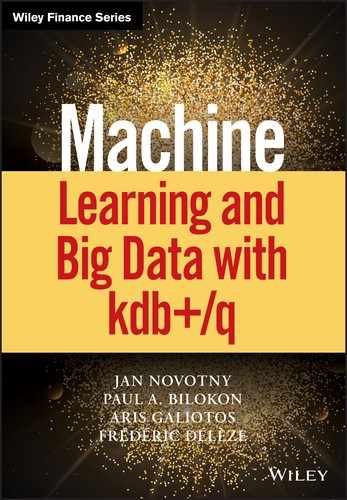Book Description
Upgrade your programming language to more effectively handle high-frequency data
Machine Learning and Big Data with KDB+/Q offers quants, programmers and algorithmic traders a practical entry into the powerful but non-intuitive kdb+ database and q programming language. Ideally designed to handle the speed and volume of high-frequency financial data at sell- and buy-side institutions, these tools have become the de facto standard; this book provides the foundational knowledge practitioners need to work effectively with this rapidly-evolving approach to analytical trading.
The discussion follows the natural progression of working strategy development to allow hands-on learning in a familiar sphere, illustrating the contrast of efficiency and capability between the q language and other programming approaches. Rather than an all-encompassing “bible”-type reference, this book is designed with a focus on real-world practicality to help you quickly get up to speed and become productive with the language.
- Understand why kdb+/q is the ideal solution for high-frequency data
- Delve into “meat” of q programming to solve practical economic problems
- Perform everyday operations including basic regressions, cointegration, volatility estimation, modelling and more
- Learn advanced techniques from market impact and microstructure analyses to machine learning techniques including neural networks
The kdb+ database and its underlying programming language q offer unprecedented speed and capability. As trading algorithms and financial models grow ever more complex against the markets they seek to predict, they encompass an ever-larger swath of data – more variables, more metrics, more responsiveness and altogether more “moving parts.”
Traditional programming languages are increasingly failing to accommodate the growing speed and volume of data, and lack the necessary flexibility that cutting-edge financial modelling demands. Machine Learning and Big Data with KDB+/Q opens up the technology and flattens the learning curve to help you quickly adopt a more effective set of tools.
Table of Contents
- Cover
- Preface
- About the Authors
- PART One: Language Fundamentals
- PART Two: Data Operations
- PART Three: Data Science
- CHAPTER 12: Basic Overview of Statistics
- CHAPTER 13: Linear Regression
- 13.1 LINEAR REGRESSION
- 13.2 ORDINARY LEAST SQUARES
- 13.3 THE GEOMETRIC REPRESENTATION OF LINEAR REGRESSION
- 13.4 IMPLEMENTATION OF THE OLS
- 13.5 SIGNIFICANCE OF PARAMETERS
- 13.6 HOW GOOD IS THE FIT: R2
- 13.7 RELATIONSHIP WITH MAXIMUM LIKELIHOOD ESTIMATION AND AIC WITH SMALL SAMPLE CORRECTION
- 13.8 ESTIMATION SUITE
- 13.9 COMPARING TWO NESTED MODELS: TOWARDS A STOPPING RULE
- 13.10 IN‐/OUT‐OF‐SAMPLE OPERATIONS
- 13.11 CROSS‐VALIDATION
- 13.12 CONCLUSION
- CHAPTER 14: Time Series Econometrics
- CHAPTER 15: Fourier Transform
- CHAPTER 16: Eigensystem and PCA
- CHAPTER 17: Outlier Detection
- CHAPTER 18: Simulating Asset Prices
- PART Four: Machine Learning
- CHAPTER 19: Basic Principles of Machine Learning
- CHAPTER 20: Linear Regression with Regularisation
- CHAPTER 21: Nearest Neighbours
- CHAPTER 22: Neural Networks
- CHAPTER 23: AdaBoost with Stumps
- CHAPTER 24: Trees
- CHAPTER 25: Forests
- CHAPTER 26: Unsupervised Machine Learning: The Apriori Algorithm
- CHAPTER 27: Processing Information
- CHAPTER 28: Towards AI – Monte Carlo Tree Search
- CHAPTER 29: Econophysics: The Agent‐Based Computational Models
- CHAPTER 30: Epilogue: Art
- Bibliography
- Index
- End User License Agreement
